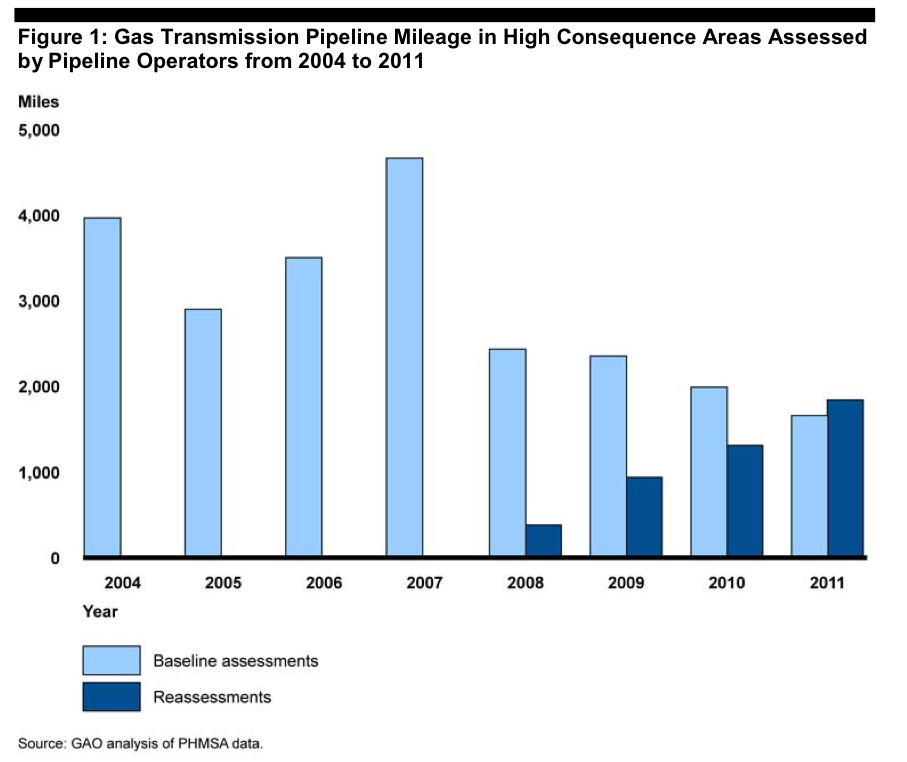UNITED STATES GOVERNMENT ACCOUNTABILITY OFFICE
Background
The United States has a network of about 300,000 miles of gas transmission pipelines that are owned and operated by approximately 900 operators. These pipelines, which are primarily interstate, typically move gas products over long distances from sources to communities, and tend to operate at the highest pressures and have the largest diameters of any type of pipeline. Gas transmission pipelines are critical because they transport nearly all of the natural gas used in the United States, which fuels about a quarter of the nation’s energy needs. Pipelines do not experience many of the safety threats faced by other forms of freight transportation because they are mostly underground. However, they are subject to problems that can occur over time (such as leaks and ruptures resulting from corrosion) or are independent of time (such as damage from excavation, land movement, or incorrect operation).
PHMSA administers the national regulatory program to ensure the safe transportation of natural gas and hazardous liquids (e.g., petroleum or anhydrous ammonia) by pipeline, including developing safety requirements that all pipeline operators regulated by PHMSA must meet. In fiscal year 2012, the agency’s total budget was $201 million, about half of which is for pipeline safety activities. PHMSA’s Office of Pipeline Safety employs over 200 staff, with about 135 of those staff involved in inspections and enforcement. In addition, over 300 state inspectors help oversee pipelines and ensure safety.
Pipeline operators are subject to PHMSA’s minimum safety standards for the design, construction, testing, inspection, operation, and maintenance of gas transmission pipelines. However, this approach does not systematically account for differences in the kinds of threats and the degrees of risk that individual pipelines face. For example, pipelines located in the Pacific Northwest are more susceptible to damage from geologic hazards, such as land movement, than pipelines in some other areas of the country. Federal efforts to incorporate risk-based concepts into pipeline management began in earnest in the mid-1990s. For example, the Accountable Pipeline Safety and Partnership Act of 1996 required the Department of Transportation to establish risk management demonstration projects. The purpose of this effort was “to demonstrate, through the voluntary participation by owners and operators of gas pipeline facilities and hazardous liquid facilities, the application of risk management; and to evaluate the safety and cost-effectiveness of the program.” These projects helped PHMSA establish a more risk-based approach to safety: the integrity management program. Integrity management helps ensure safety by, among other things, using information to identify and assess risks and prioritizing risks so that resources may be allocated to address higher risks first. The integrity management program requires operators to perform a number of activities, such as identifying high consequence areas and pipelines within those areas, as well as identifying the threats facing those pipelines. PHMSA first implemented integrity management requirements for hazardous liquid pipeline operators with 500 or more miles of pipelines in December 2000, followed by hazardous liquid pipeline operators with less than 500 miles in January 2002. The Pipeline Safety Improvement Act of 2002 extended the integrity management program to gas transmission pipelines, which include about 20,000 miles of pipeline segments located in high consequence areas. In addition to being subject to PHMSA’s integrity management program, operators must still meet the minimum safety standards noted above.
As part of the integrity management program, operators are required to assess the integrity of their pipelines within high consequence areas on a regular basis using approved methods. Specifically, gas transmission pipeline operators were required to complete a baseline assessment on pipeline segments within high consequence areas by December 17, 2012. According to the 2002 act, operators are then required to complete reassessments of these pipelines at least every 7 years. Gas transmission pipeline operators completed most baseline assessments by December 17, 2012, and reassessments are currently under way. From 2004 through December 2011 (the latest data available), baseline assessments were conducted on over 23,450 miles of gas transmission pipeline in high consequence areas. Over 4,470 miles of gas transmission pipeline in high consequence areas—or about 20 percent of the pipeline miles that had a completed baseline assessment between 2004 and 2011—were reported as reassessed between 2008 and 2011 (see fig. 1). Among other things, PHMSA’s integrity management regulations required operators to (1) prioritize their baseline assessments to assess riskier pipelines first and (2) complete baseline assessments of these riskier pipelines by December 2007, and all pipelines within high consequence areas by December 2012. As a result, a small spike in the mileage assessed occurred in 2007.
Read full report (PDF) here: Gas Pipeline Safety
About the Government Accountability Office (GAO)
www.gao.gov
“The U.S. Government Accountability Office (GAO) is an independent, nonpartisan agency that works for Congress. Often called the “congressional watchdog,” GAO investigates how the federal government spends taxpayer dollars. The head of GAO, the Comptroller General of the United States, is appointed to a 15-year term by the President from a slate of candidates Congress proposes. Gene L. Dodaro became the eighth Comptroller General of the United States and head of the U.S. Government Accountability Office (GAO) on December 22, 2010, when he was confirmed by the United States Senate. He was nominated by President Obama in September of 2010 and had been serving as Acting Comptroller General since March of 2008.”
Tags: GAO, Gas Pipeline Safety







 RSS Feed
RSS Feed